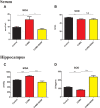Intranasal Administration of Brain-Derived Neurotrophic Factor Rescues Depressive-Like Phenotypes in Chronic Unpredictable Mild Stress Mice
- PMID: 36062024
- PMCID: PMC9438797
- DOI: 10.2147/NDT.S369412
Intranasal Administration of Brain-Derived Neurotrophic Factor Rescues Depressive-Like Phenotypes in Chronic Unpredictable Mild Stress Mice
Abstract
Introduction: Major depression disorder is the most common diagnosed mental illnesses, and it bring a high social and economic burden. However, the current treatment for depression has limitations with side effects. Hence, there is an urgent need to search more effective treatment for major depressive disorder. Brain-derived neurotrophic factor (BDNF) is a neurotrophin that is vital to the survival, growth, and maintenance of neurons.
Methods: We administered BDNF into chronic unpredictable mild stress (CUMS)-induced depression mice and assessed the effects of intranasal delivery of BDNF in depression by the tail suspension test, forced swimming test, novelty suppressed feeding test, and open-field test.
Results: We find that the intranasal administration of BDNF reversed the depressive-like behaviors in CUMS mice as measured Further analyses suggested that BDNF treatment reduced pro-inflammatory cytokine (IL-6, TNF-α, iNOS and IL-1β) expressions in the hippocampus of CUMS mice. In addition, our results showed that BDNF markedly reduced oxidative stress in the hippocampus and blood of CUMS mice. Moreover, our data suggested that BDNF treatment increased neurogenesis in the hippocampus of CUMS mice.
Discussion: Taken together, our results for the first time demonstrated that intranasal delivery of BDNF protein exhibited anti-depressant-like effects in mice, and therefore may represent a new therapeutic strategy for major depressive disorder.
Keywords: BDNF; depression; inflammatory cytokine; neurogenesis; oxidative stress.
© 2022 Li et al.
Conflict of interest statement
The authors declare that there are no conflicts of interest.
Figures





Similar articles
-
Antidepressant-like effects of the Guanxin Danshen formula via mediation of the CaMK II-CREB-BDNF signalling pathway in chronic unpredictable mild stress-induced depressive rats.Ann Transl Med. 2019 Oct;7(20):564. doi: 10.21037/atm.2019.09.39. Ann Transl Med. 2019. PMID: 31807545 Free PMC article.
-
Emodin opposes chronic unpredictable mild stress induced depressive-like behavior in mice by upregulating the levels of hippocampal glucocorticoid receptor and brain-derived neurotrophic factor.Fitoterapia. 2014 Oct;98:1-10. doi: 10.1016/j.fitote.2014.06.007. Epub 2014 Jun 14. Fitoterapia. 2014. PMID: 24932776
-
Seahorse treatment improves depression-like behavior in mice exposed to CUMS through reducing inflammation/oxidants and restoring neurotransmitter and neurotrophin function.J Ethnopharmacol. 2020 Mar 25;250:112487. doi: 10.1016/j.jep.2019.112487. Epub 2019 Dec 17. J Ethnopharmacol. 2020. PMID: 31857128
-
BDNF Unveiled: Exploring Its Role in Major Depression Disorder Serotonergic Imbalance and Associated Stress Conditions.Pharmaceutics. 2023 Aug 3;15(8):2081. doi: 10.3390/pharmaceutics15082081. Pharmaceutics. 2023. PMID: 37631295 Free PMC article. Review.
-
Chronic Unpredictable Mild Stress Model of Depression: Possible Sources of Poor Reproducibility and Latent Variables.Biology (Basel). 2022 Nov 6;11(11):1621. doi: 10.3390/biology11111621. Biology (Basel). 2022. PMID: 36358321 Free PMC article. Review.
Cited by
-
The Nasal-Brain Drug Delivery Route: Mechanisms and Applications to Central Nervous System Diseases.MedComm (2020). 2025 Jun 6;6(6):e70213. doi: 10.1002/mco2.70213. eCollection 2025 Jun. MedComm (2020). 2025. PMID: 40487748 Free PMC article. Review.
-
Cuscutae Semen in depression-induced ovarian dysfunction: metabolomics with UPLC-QToF-MS in female mice.Front Mol Biosci. 2025 Apr 30;12:1595602. doi: 10.3389/fmolb.2025.1595602. eCollection 2025. Front Mol Biosci. 2025. PMID: 40370520 Free PMC article.
-
Intranasal Administration of BDNF Improves Recovery and Promotes Neural Plasticity in a Neonatal Mouse Model of Hypoxic Ischemia.Exp Neurobiol. 2024 Feb 29;33(1):25-35. doi: 10.5607/en23030. Exp Neurobiol. 2024. PMID: 38471802 Free PMC article.
-
Implications of neurogenesis in depression through BDNF: rodent models, regulatory pathways, gut microbiota, and potential therapy.Mol Psychiatry. 2025 Sep;30(9):4409-4421. doi: 10.1038/s41380-025-03044-7. Epub 2025 May 9. Mol Psychiatry. 2025. PMID: 40341897 Review.
References
LinkOut - more resources
Full Text Sources

